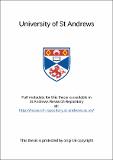Files in this item
Appetitive associative conditioning in the basolateral amygdala
Item metadata
| dc.contributor.author | Birch, Claire Stirling | en |
| dc.coverage.spatial | ix, 276 p : ill. (some col.) 30 cm. | en |
| dc.date.accessioned | 2021-04-08T09:04:10Z | |
| dc.date.available | 2021-04-08T09:04:10Z | |
| dc.date.issued | 2005 | |
| dc.identifier.uri | https://hdl.handle.net/10023/21993 | |
| dc.description.abstract | This thesis is concerned with the neural basis of appetitive associative conditioning or 'reward learning' in rats. Research has implicated several brain structures within what is known as the cortico-striato-pallido-thalamic or 'limbic' loop in reward learning, including the nucleus accumbens and the amygdala. Wolfram Schultz and colleagues recently proposed that dopamine neurons, which project from the midbrain ventral tegmental area (VTA) to the ventral striatum (including the nucleus accumbens), signal expectancy of reward. They have shown that, not only do dopamine neurons markedly increase their activity at the presentation of unexpected rewards, but that with training this response transfers to stimuli predictive of those rewards. Moreover, once this transfer has occurred, if an expected reward does not in fact occur, there is a brief reduction in dopaminergic activity at the time that it should have occurred. The experimental work undertaken for the first part of this thesis describes the behavioural testing of an appetitive 'blocking' paradigm which was intended to explore and substantiate Schultz et al's proposal that dopamine signals a reward prediction error by assessing whether the transfer in dopaminergic activity is indeed due to contingency or merely to temporal contiguity. The results of the blocking paradigm were inconclusive. The amygdala, closely associated with the limbic loop, has long been associated with 'emotional' behaviour with damage leading to hypoemotionality in animals and to deficits in the perception of emotions in facial expression and impaired learning of and memory for emotional events in humans. It is becoming increasingly clear that the amygdala is also important for appetitive associative learning. The experimental work undertaken for the second part of this thesis investigates the relative contributions of the basolateral nucleus of the amygdala (BLA) and the central nucleus of the amygdala (CeN) to reward learning by assessing the performance of BLA- and CeN-lesioned rats on the Schedule Fraction Cue (SFC) task. In this task rats must make three, two, or one correct responses in order to receive reward, and are able to use information provided by cue lights to notify them as to their progress. Since previous research has suggested that the BLA is critical for the acquisition of positive incentive value by formerly neutral stimuli, and since it has also been suggested that Pavlovian conditioned stimuli can exert a motivational influence on instrumental behaviour (Pavlovian-to-instrumental transfer), it was initially predicted that BLA-lesioned rats would be impaired in their performance of this task. The results of Experiment A suggested that this was not the case. More recent research has suggested that CeN lesions abolish Pavlovian-to-instrumental transfer, and so the experiment was repeated, using both BLA- and CeN-lesioned rats. The results of Experiment B showed very little impairment in performance in the BLA- or CeN lesioned rats. It is concluded that any impairments present in BLA- or CeN-lesioned rats are very subtle and will require further investigation. | en |
| dc.language.iso | en | en |
| dc.publisher | University of St Andrews | en |
| dc.subject.lcc | QP416.B5 | |
| dc.subject.lcsh | Conditioned response--Physiological aspects | en |
| dc.subject.lcsh | Amygdaloid body | en |
| dc.subject.lcsh | Rats--Physiology | en |
| dc.title | Appetitive associative conditioning in the basolateral amygdala | en |
| dc.type | Thesis | en |
| dc.type.qualificationlevel | Doctoral | en |
| dc.type.qualificationname | PhD Doctor of Philosopy | en |
| dc.publisher.institution | The University of St Andrews | en |
| dc.contributor.institution | Biology Theses | en |
This item appears in the following Collection(s)
Items in the St Andrews Research Repository are protected by copyright, with all rights reserved, unless otherwise indicated.

